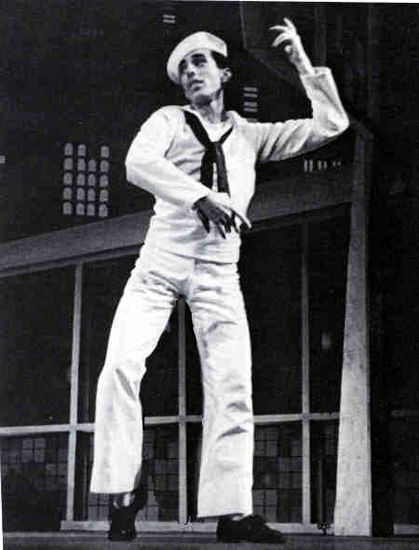Jerome Robbins (1918-1999)

Jerome Robbins, one of the most influential personalities of contemporary ballet and theater was born to Harry and Lena Robbins in New York City on October 11, 1918.. The family eventually moved to Weehawken, NJ, where Robbins graduated from Woodrow Wilson High School in 1935. He majored in chemistry at New York University, but after one year had to drop out due to lack of funds.
Robbin's interest in puppetry was his first introduction to theater. He became interested in dance through his sister Sonja, a modern dancer. This new interest grew, and he began to study with the best teachers of the time: Antony Tudor, Eugene Loring, Ella Daganova, and Helène Platova, as well as modern dance at the New Dance Group, Spanish with Helène Veola, Oriental with Yeichi Nimura, and interpretive dance with Alyce Bently and his sister Sonja. He also studied piano, violin, and took acting classes with Elia Kazan, and voice.
His first performing experience was in 1938, when he joined the Gluck Sandor-Felicia Sorel Dance Company (Robbins later cast Gluck Sandor as the Rabbi in his Fiddler on the Roof). He also briefly worked with the Yiddish Art Theatre. From 1937 to 1941 he worked at Camp Tamiment in the Pocano Mountains, where Max Liebman encouraged him to choreograph some small revues.
During this period, he also worked as a chorus boy on Broadway in Great Lady, Stars in Your Eyes, High Hat Revue and Keep Off The Grass.
In 1940 Robbins became a member of the corps de ballet of Ballet Theatre, (now American Ballet Theatre) and in 1941 was promoted to soloist. He created the roles of the youth in Three Virgins and A Devil, Benvolio in Romeo and Juliet, Hermes in Helen of Troy, the Spanish lover in Bluebeard and many other major roles, including some in his own ballets.
Robbins choreographed Fancy Free (1944) -- which later served as the senario for On the Town -- Interplay (1945), Facsimile (1947), and Summer Day (1947), all for Ballet Theatre.
In 1949 Robbins joined the New York City Ballet as a dancer and Associate Artistic Director and over the years has maintained this latter position, Among the works he has choreographed for the New York City Ballet are: Jones Beach (with George Balanchine) (1949), The Guest (1949), Age of Anxiety (1950), The Cage (1951), Ballade (1952), Fanfare (1953), Afternoon of a Faun (1953), Quartet (1954), and The Concert (1956).
For Broadway Robbins has choreographed and directed many shows: On the Town (1945), Billon Dollar Baby (1946), High Button Shoes (1947)(Tony Award, 1948), Look Ma I'm Dancin' (1948), Miss Liberty (1949), Call Me Madam (1950), The King and I (1951) and Two's Company (1952); co-directed The Pajama Game (1954), Peter Pan (1954) and Bells are Ringing (1956); conceived, directed and choreographed West Side Story (1957)( Tony Award, 1958), Gypsy (1959), Funny Girl (1964), and Fiddler On the Roof (1964)(two Tony Awards for Musical Director and Choreographer, 1965) and Jerome Robbins Broadway (1989)(Tony Award, 1989).
In 1958 Robbins left New York City Ballet to form his own company, Ballets U.S.A. For this group he choreographed Moves, and New York Export Opus Jazz. The company was a great success in Europe and in New York City, but fared less well in the rest of the United States.
Robbins also directed some straight plays, including Berthold Brecht's Mother Courage, and Arthur Kopit's Oh Dad Poor Dad, Mama's Hung You In the Closet and I'm Feeling So Sad.
In 1965 Robbins choreographed Les Noces, for American Ballet Theatre a very expensive production, but a beautiful one. Because of the large singing chorus they couldn't take it on the road. When he returned to New York City Ballet he choreographed Dances at a Gathering (1969), In The Night (1970), The Goldberg Variations and Watermill (1972). To list all of his ballets would take this entire Newsletter.
I feel safe in saying that Jerome Robbins is the most important American-trained choreographer of this century. Among his honors are an Oscar as director and choreographer for the film of West Side Story (1962), the Chevalier de l'Ordre des Arts et lettres (1964), the Capezio Award (1976), and the Kennedy Center Honors (1981).
(First published April 1998)